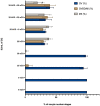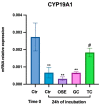IVM Advances for Early Antral Follicle-Enclosed Oocytes Coupling Reproductive Tissue Engineering to Inductive Influences of Human Chorionic Gonadotropin and Ovarian Surface Epithelium Coculture
- PMID: 37047595
- PMCID: PMC10095509
- DOI: 10.3390/ijms24076626
IVM Advances for Early Antral Follicle-Enclosed Oocytes Coupling Reproductive Tissue Engineering to Inductive Influences of Human Chorionic Gonadotropin and Ovarian Surface Epithelium Coculture
Abstract
In vitro maturation (IVM) is not a routine assisted reproductive technology (ART) for oocytes collected from early antral (EA) follicles, a large source of potentially available gametes. Despite substantial improvements in IVM in the past decade, the outcomes remain low for EA-derived oocytes due to their reduced developmental competences. To optimize IVM for ovine EA-derived oocytes, a three-dimensional (3D) scaffold-mediated follicle-enclosed oocytes (FEO) system was compared with a validated cumulus-oocyte complex (COC) protocol. Gonadotropin stimulation (eCG and/or hCG) and/or somatic cell coculture (ovarian vs. extraovarian-cell source) were supplied to both systems. The maturation rate and parthenogenetic activation were significantly improved by combining hCG stimulation with ovarian surface epithelium (OSE) cells coculture exclusively on the FEO system. Based on the data, the paracrine factors released specifically from OSE enhanced the hCG-triggering of oocyte maturation mechanisms by acting through the mural compartment (positive effect on FEO and not on COC) by stimulating the EGFR signaling. Overall, the FEO system performed on a developed reproductive scaffold proved feasible and reliable in promoting a synergic cytoplasmatic and nuclear maturation, offering a novel cultural strategy to widen the availability of mature gametes for ART.
Keywords: EGF signaling; PCL electrospun scaffold; early antral follicle; follicle-enclosed oocyte; human chorionic gonadotropin; in vitro oocyte maturation; ovarian surface epithelium; sheep.
Conflict of interest statement
The authors declare no conflict of interest.
Figures









Similar articles
-
An improved IVM method for cumulus-oocyte complexes from small follicles in polycystic ovary syndrome patients enhances oocyte competence and embryo yield.Hum Reprod. 2017 Oct 1;32(10):2056-2068. doi: 10.1093/humrep/dex262. Hum Reprod. 2017. PMID: 28938744
-
A pre-in vitro maturation medium containing cumulus oocyte complex ligand-receptor signaling molecules maintains meiotic arrest, supports the cumulus oocyte complex and improves oocyte developmental competence.Mol Hum Reprod. 2017 Sep 1;23(9):594-606. doi: 10.1093/molehr/gax032. Mol Hum Reprod. 2017. PMID: 28586460
-
Rescue in vitro maturation using ovarian support cells of human oocytes from conventional stimulation cycles yields oocytes with improved nuclear maturation and transcriptomic resemblance to in vivo matured oocytes.J Assist Reprod Genet. 2024 Aug;41(8):2021-2036. doi: 10.1007/s10815-024-03143-4. Epub 2024 May 30. J Assist Reprod Genet. 2024. PMID: 38814543 Free PMC article.
-
A fresh start for IVM: capacitating the oocyte for development using pre-IVM.Hum Reprod Update. 2024 Jan 3;30(1):3-25. doi: 10.1093/humupd/dmad023. Hum Reprod Update. 2024. PMID: 37639630 Review.
-
Metabolic co-dependence of the oocyte and cumulus cells: essential role in determining oocyte developmental competence.Hum Reprod Update. 2021 Jan 4;27(1):27-47. doi: 10.1093/humupd/dmaa043. Hum Reprod Update. 2021. PMID: 33020823 Review.
Cited by
-
The effect of single versus group culture on cumulus-oocyte complexes from early antral follicles.J Assist Reprod Genet. 2025 Mar;42(3):961-976. doi: 10.1007/s10815-025-03404-w. Epub 2025 Jan 28. J Assist Reprod Genet. 2025. PMID: 39873925 Free PMC article.
-
Revolutionizing the female reproductive system research using microfluidic chip platform.J Nanobiotechnology. 2023 Dec 19;21(1):490. doi: 10.1186/s12951-023-02258-7. J Nanobiotechnology. 2023. PMID: 38111049 Free PMC article. Review.
-
Bioengineered 3D ovarian model for long-term multiple development of preantral follicle: bridging the gap for poly(ε-caprolactone) (PCL)-based scaffold reproductive applications.Reprod Biol Endocrinol. 2024 Aug 2;22(1):95. doi: 10.1186/s12958-024-01266-y. Reprod Biol Endocrinol. 2024. PMID: 39095895 Free PMC article.
-
Investigating SMYD3 role during oocyte maturation in a 3D follicle-enclosed oocyte in vitro model in sheep.Front Cell Dev Biol. 2025 Jun 25;13:1625914. doi: 10.3389/fcell.2025.1625914. eCollection 2025. Front Cell Dev Biol. 2025. PMID: 40636673 Free PMC article.
-
The Effects of Endometrial Mesenchymal Stem Cells on The In Vitro Maturation of Germinal Vesicle Oocytes in Hanging Drop and Sodium Alginate Hydrogel Co-Culture Systems.Int J Fertil Steril. 2024 Jun 9;18(3):278-285. doi: 10.22074/ijfs.2023.2006017.1487. Int J Fertil Steril. 2024. PMID: 38973282 Free PMC article.
References
-
- Vuong L.N., Ho T.M., Gilchrist R.B., Smitz J. The Place of In Vitro Maturation in Assisted Reproductive Technology. Fertil. Reprod. 2019;1:11–15. doi: 10.1142/S2661318219300022. - DOI
-
- Walls M.L., Hunter T., Ryan J.P., Keelan J.A., Nathan E., Hart R.J. In vitro maturation as an alternative to standard in vitro fertilization for patients diagnosed with polycystic ovaries: A comparative analysis of fresh, frozen and cumulative cycle outcomes. Hum. Reprod. 2015;30:88–96. doi: 10.1093/humrep/deu248. - DOI - PubMed
MeSH terms
Substances
Grants and funding
LinkOut - more resources
Full Text Sources
Research Materials
Miscellaneous

